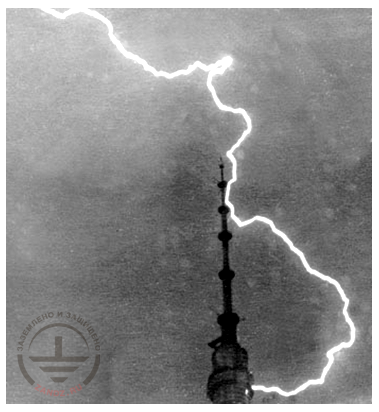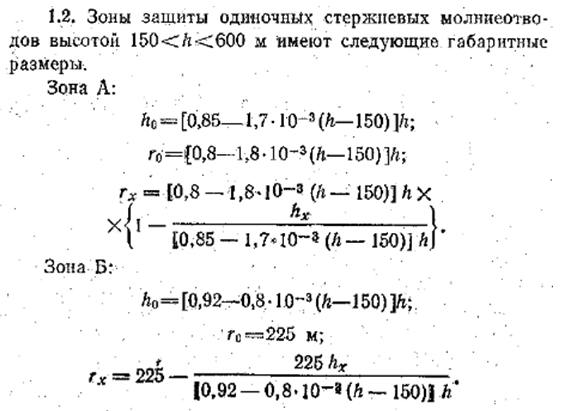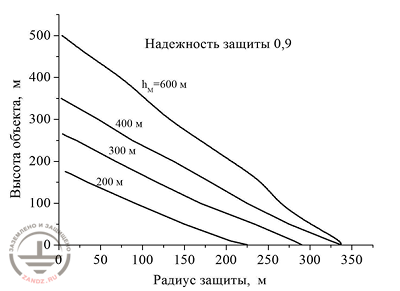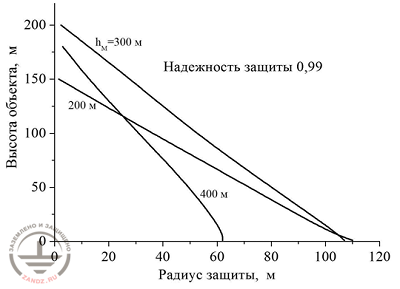To carry out a simple analysis to determine the expected number of lightning strikes in high-rise buildings, it is better to treat them as a separate group significantly exceeding the nearby objects in height. This isolated group presents itself a rod having a predetermined height h and which is able to attract lightning in the radius of 3h. The possible number of strikes can be described by the formula

where nM - the average number of discharges per year per 1 km2 of the smooth ground surface of the selected region. On the major part of the Russian territory, this index is equal to 3, although for some regions it may reach 10. Long and meticulous observations after the already exploited sites confirm the existence of a direct quadratic dependence of the amount of projected lightning strikes on the height of the top of the structures under consideration.
Lightning strikes into the highest point of the object 30 m high approximately 0.1 times per year (the probability is indicated at the absence of higher buildings nearby). At the same time a 100 m building will attract a lightning discharge once a year, and 200 -meters-building four times more often. When binding in these cases the theory with the reality, the match percentage is close to 100, if not to take into account a small feature: the downstream discharges hit the tops only in half cases from the calculated values, the rest of the lightning are ascending, and their motion starts from the upper points of the objects.

Figure 1. Lightning strikes the Ostankino TV tower*
Performing the design of lightning protection, it is necessary to take into account that at the altitudes below 200 m, the total number of atmospheric discharges drawn is also calculated by the above formula, but the percentage of upstream lightning begins to increase proportionally to the distance the top of the object from the ground surface. The main difference between the downstream and upstream breakdown is in the accuracy of their impact. The first often overshoot and can affect not only the side surfaces of the object, but also the surrounding area. Their possible trajectories are unpredictable. The latter are always predictable.
The peculiarities of operation of lightning rods when installed on high-rise buildings
Principles of settlement and determination of protection zones of high-rise lightning rods are regulated by several accepted documents, but the formulas offered in them do not always remain relevant. Instructions on lightning protection IS 153-34.21.122-2003 is applied for buildings, structures and industrial communications, not exceeding 150 m. It cannot be used on objects of great height, as there are recommendations to protect against downstream lightning.
The guide AD 34.21.122-87, describing possible scenarios in these conditions will help to foresee how high-rise lightning rods would behave at the altitides up to 600 m. The given empirical formulas for fast drainage of the lightning current to the ground are more accurate, but they also have a certain approximation. The actual protection zone for downward lightning is always significantly smaller than the zone for upward discharges. The guide only gives a rough average values of preliminary observations

Figure 2. Equations for calculating the protection zone from AD 34.21.122-87*
Here r0 And rx are radii of protective zones for the heights hx and H0, and h is the upper value of the rod height.
Determining the protective radius in zone A for the rods with the height close to 600 m with the help of these forumals, the on-ground values will be negative. h0 will move up to 0.085h, which will show the lack of protection of the side surface of the object from direct lightning hits for the heights of 0-50 m from the surface. The reliability of this assumption has not been confirmed or refuted in practice, although in the case of the Ostankino television tower, downward lightning strikes were fixed at its base (at the altitude of ~ 0,6h), and even close to the object (at the distance of 0,4h).
They revealed the possibility of a sharp decrease of the protection zone radius for downstream lightning near the ground at the increase of the building height. By learning how to protect high-rise buildings from lightning, it can be seen that the existing protection zones there are mainly focused on downward lightning and help to maximally reduced the probability of "misses". Wherein at the altitudes below 200 m, the dependence of change of such discharges attraction radius on the height is insignificant and the distance ranges between 450 and 500 m

It is possible to calculate the hypothetical number of discharges more precisely can be done with the help of preliminarily indication of the probable limit of their attraction (rM), as well as the calculation of the obtained area between the external perimeter and the rod, taking into account the density (nM) of atmospheric electricity shocks into the ground for the given region. Any object under study more than 200 m high, with the height prevailing other indexes, will receive the number of downstream discharges, calculated by the formula

Only a certain part of such breakdowns will be able to break through the protective zone of the object, hitting it between the base and the apex. By installing a high-rise lightning rod above the building, with the reliable protection P, one will manage to reduce the number of breakthroughs during the year to the following estimated values

Figure 3. The results of calculation of the protection zone with a protection reliability of 0.9*

Figure 4. The results of calculating the protection zone with a protection reliability of 0.99*
Высота объекта, м – object height, m
Надежность защиты – protection reliability
Радиус защиты, м – protection radius, m
* - illustrations are taken from the article of prof. E. M. Bazelyan "Lightning protection of high-rise buildings"
See also:
- What is offered by companies manufacturing active lightning protection
- Album of standard solutions on grounding and lightning protection
- Video recording of the lecture "Answers to the questions of designers"
Related Articles:



